Parque Natural da Ria Formosa, Algarve, Portugal
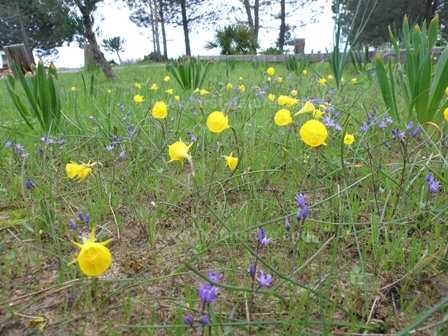
Spring Flowers at the Centre in March
The Parque Natural da Ria Formosa Centre is not signed from any direction and is extremely difficult and frustrating to find. It took us four attempts on separate visits to the Algarve to get there finally. As we were travelling from the mid-Algarve by car, our wandering cannot be described as an environmentally-friendly activity, but nevertheless this important site (it is designated under the RAMSAR convention as a wetlands reserve of worldwide signficance) is very well worth a visit.
Directions
From the A22, turn off at the Olhao junction and proceed approx 8km towards Olhao. Upon reaching the roundabout on the N125 at Olhao, turn right and drive approx 400m towards Olhao Centre and then turn left down Avenida Parque Natural da Ria Formosa. (There is a petrol station on that junction.) Proceed past a campsite and over a railway track, and about 1km further on the entrance to the Parque Natural is through large, double gates on the left.
As we write this we are in the middle of a global economic downturn, and Portugal is suffering worse than many other countries as a result of it. It would perhaps be a kindness to attribute the generally rundown appearance of the Centre at Ria da Formosa to the current economic climate, but since it was established in 1987 it is more likely, in our opinion, that the overall shabbiness of the reserve, the litter found throughout, and the row of rusting vehicles outside the Centre, is part of a deeper malaise that affects a country still struggling to change its outlook from that of a dictatorship to one where enterprise and initiative can make the difference between success and failure. Many countries would give a lot to have such a Centre and facilities, and with a bit of entrepreneurship this magnificent natural resource could become a ‘must visit’ location in the Algarve for anyone who visits or lives here – assuming they can find it. And this is why:
General Description
This 18,400 hectare site extends from Anção in the east as far as Vila Real de Santo Antonio westwards – covering some 60 kilometres of the eastern Algarve Coast. Running opposite and parallel to the coastal edge of the reserve is the barrier island system of Ria Formosa, which protects a warm-water lagoon with its mosaic of salt marshes, islets and tidal mud flats. This unique environment harbours many resident and migratory birds and offers shelter to other threatened species of fish, plants and animals.
The Birds of Parque Natural da Ria Formosa
The Park is a major stop-over point in the bird migration routes between Europe and Africa, and is a wintering ground for birds from northern and central Europe. Several duck species such as Wigeon (Anas penelope), Teal (Anas crecca), Shoveler (Anas clypeata) and Pochard (Aythya ferina) can be found here; and waders including Dunlin (Calidris alpina), Curlew (Numenius arquata), Bar-tailed Godwit (Limosa lapponica) and Grey Plover (Pluvialis squatarola) are also present in winter. The Ludo Quinta do Lago area is the only confirmed breeding ground of the Purple Gallinule (Porphyrio porphyri), and hence this bird is used as the symbol of Parque Natural da Ria Formosa.
Plants of Parque Natural da Ria Formosa
The indigenous plants fall into two categories: those found in salt-marsh habitat, and those that are mainly associated with sand dune systems. Without question, the salt-marsh ‘star attractions’ are the excellent displays of Cistanche Phelypaea – a member of the Orobanchaceae (Broomrape) family. These fascinating, parasitic plants, with their bright yellow flowers, are found only in southern Portugal, southern Spain and on Crete and a few parts of the extreme eastern Mediterranean. Cistanche phelypaea is parasitic on woody members of the Chenopodiacea family of which the glassworts are particularly well represented at Ria Formosa. Also present in the salt-marsh is a Sea Lavender, Limonium algarvense, which is endemic to this region of Portugal.
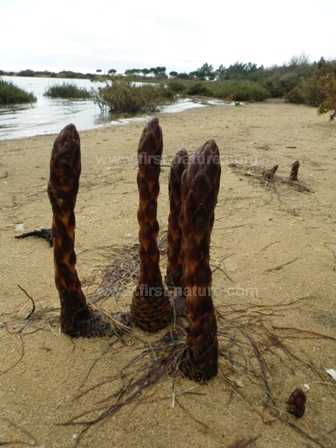
Cistanche spring up at the edge of the saltwater in springtime
Further back from the sea, in the drier areas, can be found bindweeds, Sea Daffodil (Pancratium maritimum), Thrift (Armeria pungens) and the intense blue flowers of Shrubby Pimpernel (Anagallis monelli). In the spring there are lovely displays of Grape Hyacinth, Yellow Hoop-petticoat Daffodil (Narcissus bulbocodium), Scilla monophyllos' and both the Mirror Orchid (Ophrys speculum) and Bumblebee Orchid (Ophrys bombyliflora) can be found in good numbers, especially the latter which is able to reproduce vegetatively and therefore forms large colonies.
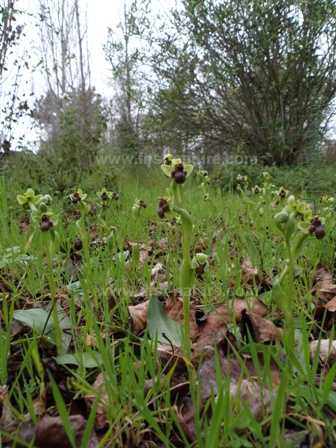
Hordes of Bumblebee Orchids near the Centre
There is also a large area of open pine woodland in the reserve, and it is in here that the elusive and beautiful Fritillaria lusitanica flowers in late February and March. Both in spring and autumn the pine woodland, with its deep layer of pine needles beneath the trees, is home to numerous fungi including pezizoid species which hug the edges of the woodland paths.
Last, but not least, Ria Formosa is one of the few strongholds of the European Chameleon. This shy creature, which lives in bushes, is seldom seen; but, in September each year, the females descend to the ground in order to deposit their eggs.
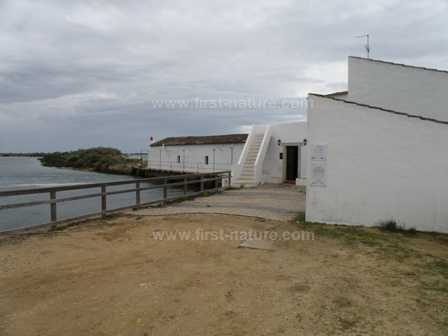
The Tide Mill at Ria Formosa
Apart from the truly outstanding opportunity that Parque Natural da Ria Formosa offers to see wildlife, there is a restored tidal mill, some Roman remains and also a museum housed within the main centre building where there are drinks machines and public toilets. There is a good boardwalk running across a large part of the reserve which, along with the level paths, makes the site accessible to wheelchairs and prams.
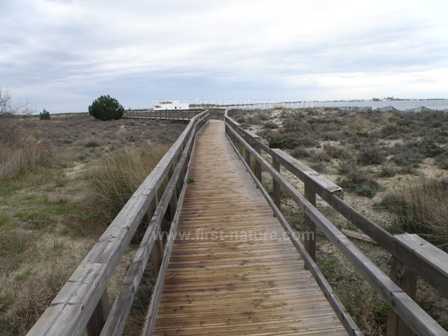
Boardwalks make access possible for wheelchair users
Please Help Us: If you have found this information interesting and useful, please consider helping to keep First Nature online by making a small donation towards the web hosting and internet costs.
Any donations over and above the essential running costs will help support the conservation work of Plantlife, the Rivers Trust and charitable botanic gardens - as do author royalties and publisher proceeds from books by Pat and Sue.

